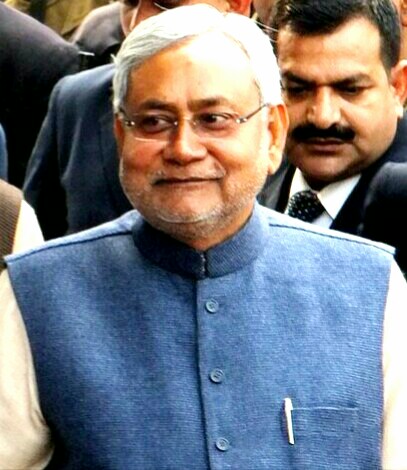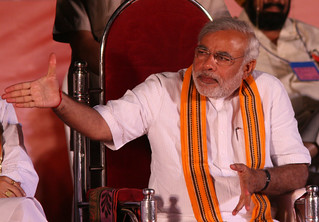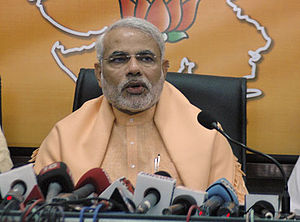 |
| English: Nitish Kumar (Photo credit: Wikipedia) |
Seven years later, over 70,000 criminals are behind bars. India’s most crime ridden, corrupt, and economically failing state is now one of the best governed and perhaps the most effective in fighting corruption...... Don’t be surprised if Nitish (as he is generally called), and not Modi, ends up becoming prime minister of India someday. ..... Modi's opponents are so numerous and strong that he may not be a viable Prime Minister. ..... Nitish, by comparison, has few detractors— other than the 70,000 criminals he helped to convict. Even Prime Minister Manmohan Singh (the man he could replace) has praised the “…Nitish government in many areas, including administrative reforms.” Though Nitish’s JDU party is mostly limited to his home state of Bihar, its agenda cuts across caste and religion. ..... If Bihar’s chief minister ends up becoming prime minister, it will have been for two reasons: his accomplishments in a key rural state; and his ability to master the dynamics of India’s coalition, religion and caste-politics. ....... When Nitish took over, many had written-off Bihar as a failed state whose most prominent industry was kidnapping, and whose biggest export was people. ..... Bihar’s greatest revenues were their remittances. Elsewhere in India, politicians would run nativist campaigns against Bihari immigrants. ...... Worse than in almost any other state, Lalu tacitly allowed local criminals to run small, well-armed fiefdoms. ...... did not expect much of Nitish. Nitish was a former Lalu deputy who came from a different lower caste, and several candidates in his Janata Dal United (JDU) party had criminal backgrounds. “Even in defeat, Lalu’s logic lived on,” wrote Ed Luce. “I have little doubt that he will be back.” ...... Nitish’s combination of courage and fairness. Nitish overhauled his police force— recruiting younger officers, upgrading its equipment, and even pulling in the army reserve for a time. But what was most important— and difficult— was applying the law equally across caste and political lines. “The key,” Nitish told me, “was willpower and determination to be fair.” ...... Nitish worked with police and prosecutors to emphasize not just arrests, but open and expeditious trials. They convinced witnesses to testify, personally vouching for their safety. “What was important was to send a signal that [their] government was competent.” Bihar’s trial and conviction rates went from being among the worst in India, to right near the top. ...... Nitish demanded that all civil servants declare their assets each year, then posted those disclosures on the state’s website. ..... He then focused on the economy. In his first five years— from 2005-2009— the state grew on average at 11%. The state reported 14% growth in 2010-2011. ...... Per capita income was below $300/year. It has almost doubled in seven years, but is still under $500/year— less than a third that of Gujarat. ........ In a territory smaller than Arkansas, Bihar has thirty times the population. In other words, Bihar squeezes 100 million people— as many as all of rural America— into a state that is only about 250 miles across its mid-section. And though it is densely populated, it is dramatically rural. Nine out of ten Biharis live in the countryside; its biggest city, Patna, has only 5 million people. ...... His goal was to get them all paved, and to connect them with broadband wireless. ..... Better roads also made it easier for kids to get to school— which Nitish says is his passion ......... hired 150,000 new teachers. ........ “Women voted irrespective of caste for Nitish Kumar in 2009,” explained Amitabh Srivastava, a Bihar-based reporter for India Today. “Nitish created a caste-neutral constituency of women. That was his social and political breakthrough.” ........ migration is down 25%-30%, causing shortages and wage increases on construction worksites as far afield as Mumbai and Chennai ...... Nitish is extremely popular in Bihar. In 2010, in a four-party race, his party ran in coalition with the nationalist BJP. Together the two parties won a commanding 80% of the state assembly— with Nitish’s party getting the lion’s share. ....... Four of India’s most important states are now governed by local parties. Uttar Pradesh, Bihar, West Bengal, and Tamil Nadu together have a population just short of 500 million. Like Nitish’s, these local parties increasingly appeal across caste and religion to “All-India.” ........... The BJP ... across India the party still largely appeals to upper caste Hindus and urban dwellers. .... Parties such as Nitish’s JDU or Akilesh Yadev’s Socialists or Jayalalitha’s AIADMK that depend on Muslim support are less willing to let the BJP lead a national coalition. ...... his caste-neutral, religion-neutral appeal ..... these parties could form a new coalition that presents an “All-India” mosaic made up of many local colors.Nitish Kumar launches food security law with 5 kg of rice, wheat priced at Rs 3, Rs 2
Lok Sabha elections: Nitish Kumar leads initiative to form ‘Third Front’
Does Nitish Kumar Need the B.J.P.?
Muslims make up 17 percent of the electorate in Bihar, and they voted overwhelmingly for Janata Dal (United) in the last state election in 2010.A Person of the Year: Nitish Kumar
Driving through a maze-like slum in Patna in the thick of election campaigning last month, chief minister Nitish Kumar’s driver lost his way. He said he needed to stop to ask for directions to a particular colony....... “Don’t worry,” Kumar told him. “I have cycled through these lanes a thousand times in my younger days,” he told the driver while giving him directions to the venue.......... keenly understands the intricate socio-political alignments and aspirations of his people ..... rewrite the equations of identity politics in the state ...... “The most obvious trait of Nitish Kumar in his younger days was the simple manner in which he lived, sharing a one-room shelter with a friend in Patna, and the amount of tireless groundwork he used to do in his constituency” ......... Murders were routine affairs and kidnapping-for-ransom was a lucrative industry ‘growing’ at about 15% every year. Bihar was virtually at the bottom of every development ranking until Nitish Kumar took charge in 2005. ...... The state’s economy grew an average 11.35% each year between 2004 and 2009, compared with 3.5% in the prior five years. In the past five years, social spending in the state rose from 30.5% to 41% of overall expenditure. The administration built 2,400 km of roads the last year alone, compared with just 415 km in 2004. ....... In order to make it clear that he meant business, Nitish Kumar first cranked up the criminal justice system. According to one bureaucrat, it took only a one-line administrative order which said that every FIR had to result in a charge sheet within 90 days and the police officer had to appear before court whenever asked to. The result: 54,000 criminals convicted in the past five years. The number of murders reported has fallen by three percentage points between 2005 and 2008. ....... Nitish Kumar was born in Bakhtiyarpur district and graduated in electrical engineering from the Bihar College of Engineering. Kumar and Lalu Yadav started their political careers together during the Jayaprakash Narayan movement in 1973-74. While Yadav was known as the crowd-puller, Kumar was a deft communicator who could explain to outsiders what the movement was about. The anti-Congress JP movement was largely a backward-caste driven one. Yadav represented the Yadavs and Kumar was the face of the Kurmis, a landowning, backward- caste people. ......... Nitish Kumar had become the union minister of state for agriculture in the V.P. Singh government of 1989- 1990 and then union minister of railways in the A.B. Vajpayee Cabinet. ....... Yadav joined hands with the Congress and secured himself a cabinet berth heading the Railways Ministry. He engineered a turnaround so spectacular that it became a case study in business schools. However, many Railways insiders say that the credit must go to Kumar, who had preceded him in the ministry during the National Democratic Alliance government led by the BJP. ........... Officials say that the financial turnaround during the Yadav years was possible only due to the substantial work in improvement of railway lines and time-keeping of passenger trains that was done during the Kumar regime. ...... “The turnaround of the Railways was actually set in motion by Nitish Kumar who carried out substantial asset replacement which helped the succeeding Lalu administration move more goods on the track,” says R. Sivadasan, former member of the railway board. ...... One of the significant decisions that Kumar took soon after coming to power in Bihar in 2005 was to reserve half of the seats in Panchayats for women. ...... “Kumar fought for reservation for women even though Sharad Yadav lobbied against it in Parliament. This was a huge factor in getting votes across caste lines. He faced a lot of revolt within the party on this. But he stood his ground and he acted as if Sharad Yadav’s views were personal” ....... close to 12 lakh students have been gifted bicycles. ....... 10% more women turned up at polling booths ..... hard-nosed identity politics. ....... A state commission constituted to identify sub-castes for targeting government help, recommended 21 out of 22 sub-castes to be classified as Mahadalits. The Dussadhs also known as Paswans, led by Ram Vilas Paswan, who form 31% of the 1.3 crore scheduled caste population in Bihar, were left out of that list. However, the government said that all the benefits given to Mahadalits will also be available to the landless Dussadhs but denied to the creamy layer of the community. It won Kumar the trust of a large section of the low-caste population. ....... His most formidable political achievement, however, was the manner in which he managed to wrest Muslim votes from Lalu Prasad Yadav. ....... “Nitish Kumar is one of the finest problem solvers in the country. Lalu commanded around 27% of the votes through his Muslim- Yadav combination. Nitish broke the pattern very intelligently,” says Ali Anwar of the All India Pasmanda Muslims Mahaz, which played a significant role in swinging the Muslim votes in Nitish’s favour. .... The Pasmanda Muslims are considered to be lower caste and account for close to 80% of the Muslim vote in the state. It was a political balancing act of considerable finesse as Kumar’s alliance partner is the BJP. He let it be known widely that the alliance was merely for the numbers and he would keep the BJP and its agenda at bay. The message was loud and clear when he made it known that he would not let BJP leader and Gujarat chief minister Narendra Modi campaign in his state. ................ “Nitish took up our cause for Scheduled Caste status for Dalit Muslims and Dalit Christians in Parliament. He did this despite being supported by the Bharatiya Janata Party. In fact he was opposed by the BJP on the floor of the house. But he stood his ground,” says Anwar. ........ expediting the inquiry into the Bhagalpur riots of 1989 which led to the conviction of 14 people in the case that involved the massacre of 116 people, including women and children. Many of the accused in the case belonged to the Yadav caste which was thought to be a reason for the lack of enthusiasm on the part of Lalu Yadav to get the case going. ......... He has brought in a law to strip officials off their assets if they are found to be disproportionate to their income. He is also planning legislation to make government services a citizen’s right. ...... Only Bengal and Kerala have managed to redistribute land to the poorer sections, that too with limited success.Narendra Modi And Nitish Kumar: A Tale Of Two Friends
the BJP is dependent on Nitish and not the other way round. ...... In the Presidential elections of 2012, Nitish did not support the BJP’s candidate. He supported the Congress nominee Pranab Mukherjee and was once again patted on the back by the media for his “secularism”. The media did not care to enlighten us as to what secularism had to do with this. Was the BJP-backed Sangma communal? ....... I am not among those who have given a clean chit to Modi in the post-Godhra communal riots or have forgotten Advani's role in the Babri demolition. The 2002 riots in Gujarat were horrible and as chief minister, it was Modi's duty to stop the violence. I hold Modi guilty even today. But, was he alone guilty? At that time, Atal Behari Vaypayee’s government was ruling at the Centre. Why did it not dismiss the Gujarat government? After all, Vajpayee had the precedent of dismissal of a string of state governments after the demolition of the Babri masjid. Just before the riots, the Bihar government was dismissed for the ‘Senari massacre’. The Gujarat riots were much more serious and sinister than ‘Senari massacre’. When the Bihar government could be sacked for one single massacre why couldn't the government of Gujarat be dismissed? Was Modi alone guilty of not following the ‘rajdharma’? What sort of ‘rajdharma’ was Vajpayee following? ...... And Nitish Kumar--who considers Vajpayee a messiah--which ‘rajdharma’ did he follow? It should not be forgotten that Nitish Kumar was the Railways minister when the Godhra train arson took place. Nitish Kumar, who had offered to resign after the Gaisal train mishap did not even care to visit the site of the Godhra tragedy. ...... The role of both Narendra Modi and Nitish Kumar in the Godhra train tragedy is not above reproach. Both of them and subsequently their common political ideal, Atal Bihari Vajpayee,did not fulfill the ‘rajdharma’. Both are publicity-crazy and both are self-anointed ‘Vikash Purush’. ....... While Nitish Kumar comes from a kulak Kurmi family of Bihar, Narendra Modi hails from an extremely poor and most backward class Ghanchi family of Gujarat. Nitish's father was an Ayervedic ‘Vaidyaraj’ and a Congress leader while Narendra's father was a small-time tea vendor. Narendra Modi spent his childhood washing the used glasses at his father’s shop when Nitish was studying Engineering, Narendra was the domestic helper in a lawyer family’s home where his responsibilities included cleaning 9 rooms and preparing food for 15 members of the family. He somehow studied and acquired degrees by appearing in exams as private student. Whatever he learned, he learned in the school of hard knocks. He might be associated with rightist politics but his childhood was as full of struggle as that of the Russian writer Maxim Gorky. There is another crucial difference between Narendra and Nitish. Even as a chief minister, the former led a simple life. He maintained a safe distance from sycophants. He also avoided associating himself with tainted persons.





















































